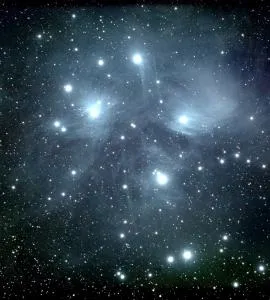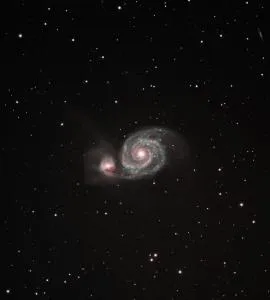The Statue of Liberty Nebula NGC 3576 with the biggest stars in the Milky Way

The Statue of Liberty Nebula NGC 3576 is a stunning emission nebula located in the Carina constellation. This awe-inspiring celestial wonder, situated approximately 9,000 light-years away from Earth, and almost the size of the full moon offers a vivid spectacle in the night sky.
NGC 3576, also known as the Statue of Liberty Nebula is a 10th magnitude bright nebula emission nebula located in the constellation Carina (southeren hemisphre), about 9,000 light-years away from Earth. NGC 3576 appears roughly 20.0 x 15.0 arcminutes in size (a full moon is 21 arcminutes wide)
What's happening in the Statue of Liberty nebula?
Luminous stars and intriguing molecules are emerging and becoming free within the dynamic nebula situated in the star-forming area known as RCW 57. This captivating image reveals dense clumps of cosmic dust, recently formed bright stars, swathes of radiant hydrogen gas energized by these stars, and impressive arcs of gas ejected from expiring stars. An in-depth examination of NGC 3576, also identified as NGC 3582 and NGC 3584, revealed the existence of at least 33 massive stars in their final stages of formation, alongside the distinct presence of complex carbon compounds called polycyclic aromatic hydrocarbons (PAHs). These PAHs, believed to form in the cooling gases of star-forming regions, may have played a crucial role in the evolution of life on Earth.
The Statue of Liberty Nebula, NGC 3576 Details
- Appearance and Structure: The nebula is known for its intricate patterns of gas and dust, which create a stunning visual spectacle in the night sky. The nickname "Statue of Liberty Nebula" arises from its resemblance to the famous statue, especially when viewed through high-powered telescopes or in processed astrophotography images. The nebula's structure is shaped by the intense radiation and winds from young, massive stars within it.
- Star Formation: NGC 3576 is a site of active star formation. The nebula contains a significant number of young, massive stars that have recently formed from its gas and dust. These stars are responsible for ionizing the surrounding gas, causing it to glow and emit light in various wavelengths.
- Scientific Interest: Astronomers study NGC 3576 to gain insights into the process of star formation and the evolution of emission nebulae. The nebula's complex structure, including its filaments, arcs, and dark dust lanes, provides valuable information about the interaction between newly formed stars and their natal environment.
- Observation: Observing NGC 3576 can be a challenge for amateur astronomers due to its southern location in the sky and its distance, which is the very reason we chose to photographic this object from Chile using the CDK24 - we are in the Ozarks!
- Relation to Other Objects: NGC 3576 is part of a larger complex of nebulae in the Carina region, which includes several other notable objects such as the Carina Nebula (NGC 3372) and the Eta Carinae star system. This region is one of the most active in terms of high-mass star formation in the nearby Milky Way galaxy.


The largest stars in the Milky Way Galaxy!
NGC 3576 is part of a larger complex in the constellation Carina, which includes several other notable NGC objects in its vicinity.
- NGC 3372 (Carina Nebula): This is one of the largest and brightest nebulae in the sky, known for its vast clouds of glowing gas and dark dust lanes. It's home to many massive stars, including the famous Eta Carinae.
- NGC 3603: This is a massive star-forming region, containing one of the most concentrated clusters of massive stars in our Milky Way galaxy.
- NGC 3532 (Wishing Well Cluster): This is an open star cluster that is quite rich and scattered, known for its stellar population and visibility to the naked eye under good conditions.
- NGC 3293: Another open star cluster, NGC 3293 is notable for its bright, blue stars and is relatively young in astronomical terms.
These NGC objects are in the same region of the sky as NGC 3576, and they are part of the extended complex of gas, dust, and stars in the Carina constellation. They share a similar galactic environment but are distinct entities with their own unique characteristics and physical properties.

How did I take this astrophoto of NGC 3576?
Telescope: PlaneWave CDK 24”
Mount: L600 Direct Drive mount
Camera: C3-61000 Pro
Guider: ZWO ASI 174mm mini as the guide camera, off axis guided
Controller: NINA
Acquisition:
11 - 900s of LRGB each (4.5 hours)
14 - 900s - Ha (3.5 hours)
14 - 900s -SII
(3.5 hours)
14 - 900s -OIII
(3.5 hours)
18.5 hours total time
Darks/Flats/Bias: (15-25 each)
Luminance: (None)
Processing: Pixinsight, Photoshop
Location: Chile
Bortle: 1
What exactly am I looking at here? Ozarks version
Alright, picture this: You know the Statue of Liberty, right? Big ol' lady with a torch, standing tall in New York Harbor? Well, imagine something kinda like that, but way up in the night sky, light-years away from Earth. That's the Statue of Liberty Nebula, or what them fancy astronomers call NGC 3576.
This nebula, it ain't just a pretty light show. It's a giant cloud of gas and dust floating in space, way out in a part of the sky we call the Carina constellation. Think of it like a big, cosmic cotton candy, glowing in all sorts of colors because of the stars around it. These young stars are so hot and bright, they make the gas light up like a neon sign at a roadside diner.
Now, why do they call it the Statue of Liberty Nebula? Well, when you look at it through a powerful telescope, parts of this nebula look like they're reaching up, kinda like the arm of the Statue of Liberty holding up her torch. It's not a perfect match, but with a bit of imagination, you can see the resemblance.
Inside this nebula, there's a whole bunch of action going on. Stars are being born out of those gas and dust clouds. It's like a nursery for baby stars, except instead of cribs and toys, you've got gravity pulling things together until they're hot and dense enough to start shining.
But here's the catch: You can't just step outside and see it with your naked eye. You need a telescope, and a pretty good one at that, to get a peek at this cosmic wonder. It's best seen from the Southern Hemisphere, so if you're up north, it might be a bit tricky to spot.
In a nutshell, the Statue of Liberty Nebula is a spectacular part of our universe, a place where stars are born and cosmic tales are written. It's a reminder that there's a whole lot more out there beyond our hills and hollers.

Locating the Status of Liberty Nebula in the night sky
Locating NGC 3576, the Statue of Liberty Nebula, in the night sky is tricky because it's not visible to the naked eye, and it's in the southern hemisphere.
Know When to Look
The Statue of Liberty Nebula is best viewed during the months when its host constellation, Carina, is prominent in the sky. This typically falls between late winter and early spring in the Southern Hemisphere.
Time of Night
The nebula will be best visible on clear, moonless nights. The ideal viewing time is usually after midnight when the sky is darkest.
Locate the Constellation Carina
Locate the constellation Carina, which is part of the larger feature known as the Southern Cross. If you're in the Southern Hemisphere, this constellation is quite prominent.
Once you've located Carina, use recognizable patterns or star arrangements within the constellation to guide you towards the nebula. The nebula lies near the open cluster NGC 3590 and is southwest of the Eta Carinae Nebula (NGC 3372).
You will need a telescope from here
Because NGC 3576 is faint and requires dark sky conditions, a telescope is necessary to view it. A telescope with a decent aperture (at least 4 inches or 100mm) and a good star chart or computerized mount will be very helpful.

The Statue of Liberty Nebula and the Bible
On this Christmas day, it's impossible to dismiss the celebration of the birth of our Saviour and how NGC 3576 is another remnant of creation made by the very hands of the same Lord who came to save us.
The enormity of The Statue of Liberty Nebula reminds me of the power of His creation and the humility He showed by coming to this planet to save us.
About the Author

Meet Richard Harris, a passionate and dedicated astronomer who embarked on a cosmic journey at the age of 11 and has been reaching for the stars ever since. Born with an innate curiosity for the universe. Richard's fascination with astronomy ignited when he first gazed up at the night sky and felt an indescribable connection to the cosmos and creation. As a younger lad, Richard spent countless hours poring over astronomy books, studying constellations, and learning about the celestial wonders that grace our skies. In 2001, Richard invented the HyperTune telescope process, which has grown into the standard for German equatorial telescope mount tuning across the globe. He is also the founder of ScopeTrader, a global resource helping to grow the hobby of astronomy which started in 2002, and the CEO of Moonbeam software company, started in 2008. When he's not taking photos of our universe, you can find him with family, playing guitar, or traveling.











